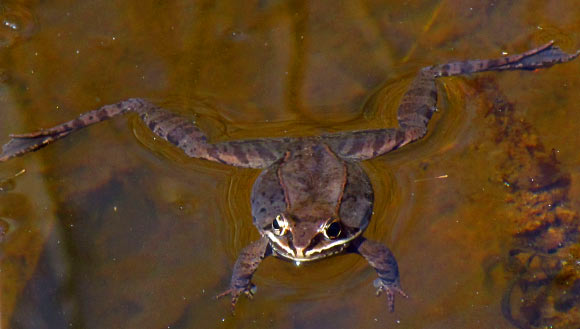According to a study led by Don Larson of the University of Alaska Fairbanks, wood frogs (Lithobates sylvaticus) freeze up to 60 percent of their bodies during the long and extremely cold Alaskan winters.

The wood frog, Lithobates sylvaticus, floating during spring mating season, Mer Bleue Conservation Area, Ottawa, Ontario, Canada. Image credit: D. Gordon E. Robertson / CC BY-SA 3.0.
Larson set out with two colleagues to study how frogs in some of the harshest conditions of Alaska alter their physiology to survive the winter months.
Unlike previous studies, they used standard lab-based experiments, but also included measurements to track a population in the wild.
The scientists tracked frogs throughout the harsh winter season. Prior to freezing for the entire season, they observed that frogs underwent 10-15 cycles of freezing and then thawing.
Thinking that such freeze-thaw cycles may be the key to the frogs’ survival through the winter season, the scientists wanted to mimic these natural conditions back in the lab. To do this, they conducted a lab experiment where frogs were left unfrozen, frozen directly, or frozen through a freeze-thaw cycle.
In the wild, all frogs survived throughout the long winter where temperatures ranged from minus 9 to minus 18 degrees Celsius, a longer and colder period than previously observed with wood frogs.
“How did they avoid becoming frog-flavored popsicles? One clue was the amount of glucose in the frog’s tissues, one of the primary agents that protect the frogs while they freeze. In both field and lab settings where the freeze/thaw cycles occurred, glucose concentrations increased between 2 and 10-fold, levels that have never been previously observed.”
“Glucose production occurs as frogs begin to freeze. Thus, the high number of freeze-thaw cycles allows for a greater increase in glucose production. This process is akin to the deliberate hyperventilation of divers prior to submerging, which serves to increase the volume of air that their lungs can consume. The frogs’ version of hyperventilation, the freeze-thaw cycles, increases their glucose levels to allow them to survive longer and colder conditions.”
While previous studies have shown that wood frogs can tolerate low temperatures for short periods of time, frogs in the current study survived longer, had a higher incidence of survival (100 percent), and survived at colder temperatures than ever previously recorded.
Moreover, the study highlights glucose as an agent for the survival of wood frogs in the harsh winter conditions.
Don Larson and his co-authors presented their findings on January 6, 2014 at the 2014 Society for Integrative and Comparative Biology Annual Conference in Austin.
Now that they have a better understanding of how a frog’s physiology changes in response to the winter season, their next step is to understand how things living inside them, such as parasites, will be affected.
They hope to use current results to shape future studies that examine the role of the cold environment on host-parasite interactions in frogs.
______







